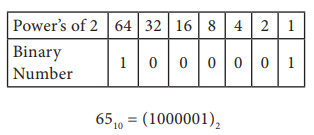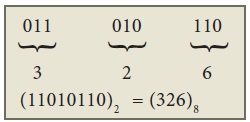Chapter: 11th Computer Science : Chapter 2 : Number Systems
Number System Conversions
Number System Conversions
1. Decimal to Binary Conversion
2. Decimal to Octal Conversion
3. Decimal to Hexadecimal
Conversion
4. Conversion of fractional
Decimal to Binary
5. Binary to Decimal Conversion
6. Binary to Octal Conversion
7. Binary to Hexadecimal
Conversion
8. Conversion of fractional Binary
to Decimal equivalent
9. Octal to Decimal Conversion
10. Octal to Binary Conversion
11. Hexadecimal to Decimal
Conversion
1. Decimal to Binary Conversion
Generally two methods followed.
Method
1: To convert Decimal to Binary “Repeated
Division by 2” method can be used. Any Decimal number divided by 2 will
leave a remainder of 0 or 1. Repeated division by 2 will leave a sequence of 0s
and 1s that become the binary equivalent of the decimal number. Suppose it is
required to convert the decimal number N into binary form, dividing N by 2 in
the decimal system, we will obtain a quotient N1 and a remainder R1, where R1
can have a value of either 0 or 1. The process is repeated until the quotient
becomes 0 or 1. When the quotient is ‘0’ or ‘1’, it is the final remainder
value. Write the final answer starting from final remainder value obtained to
the first remainder value obtained.
Example
Convert (65)10 into its
equivalent binary number

Method
2 : Sum of Powers of 2.
A decimal number can be converted
into a binary number by adding up the powers of 2 and then adding bits as
needed to obtain the total value of the number.
a) Find the largest power of 2
that is smaller than or equal to 65.
6510 > 6410
b) Set the 64’s bit to 1 and
subtract 64 from the original number
65-64=1
c) 32 is greater than the
remaining total. Therefore, set the 32’s bit to 0.
d) 16 is greater than the
remaining total. Therefore, set the 16’s bit to 0.
e) 8 is greater than the remaining
total. Therefore, set the 8’s bit to 0.
f) 4 is greater than the remaining
total. Therefore, set the 4’s bit to 0.
g) 2 is greater than the remaining
total. Therefore, set the 2’s bit to 0.
h) As the remaining value is
equivalent to 1’s bit, set it to 1.
1-1=0
Conversion is complete 6510
= (1000001)2
Example
The conversion steps can be given
as follows:
Given Number : 65
Equivalent or value less than
power of 2 is : 64
(1) 65 - 64 = 1
(2) 1 - 1= 0

2. Decimal to Octal Conversion
To convert Decimal to Octal, “Repeated Division by 8” method can be
used. The method is the same we have learnt in 2.4.1, but in this method, we
have to divide the given number by 8.
Example
Convert (65)10 into its
equivalent Octal number

3. Decimal to Hexadecimal Conversion
To convert Decimal to Hexadecimal,
“Repeated division by 16” method can
be used. The method is the same as we have learnt in 2.4.1, but in this method,
we have to divide the given number by 16.
Example
Convert (31)10 into its
equivalent hexadecimal number.

4. Conversion of fractional Decimal to Binary
The method of repeated multiplication by 2
has to be used to convert such
kind of decimal fractions.
The steps involved in the method
of repeated multiplication by 2:
Step 1: Multiply the decimal fraction by 2 and note the integer part.
The integer part is either 0 or 1.
Step 2: Discard the integer part
of the previous product. Multiply the fractional part of the previous product
by 2. Repeat Step 1 until the same fraction repeats or terminates (0).
Step 3: The resulting integer part
forms a sequence of 0s and 1s that become the binary equivalent of decimal
fraction.
Step 4: The final answer is to be written from first integer part
obtained till the last integer part obtained.

Note:
Fraction repeats, the product is
the same as in the first step.
Write the intger parts from top to bottom to obtain the equivalent fractional binary number. Hence (0.2)10=(0.00110011…)2 = (0.00110011)2
5. Binary to Decimal Conversion
To convert Binary to Decimal we
can use positional notation method.
Step 1: Write down the Binary digits and list the powers of 2 from right
to left(Positional Notation)
Step 2: For each positional
notation written for the digit, now write the equivalent weight.
Step 3: Multiply each digit with
its corresponding weight
Step 4: Add all the values.

Example
Convert (111011)2 into
its equivalent decimal number.

6. Binary to Octal Conversion
Step 1: Group the given binary number into 3 bits from right to left.
Step 2: You can add preceding 0 to
make a group of 3 bits if the left most group has less than 3 bits.
Step 3: Convert equivalent octal value using "2's power positional weight
method"

Example
Convert (11010110)2
into octal equivalent number
Step 1: Group the given number
into 3 bits from right to left.
011
010 110
Note: The left most groups have
less than 3 bits, so 0 is added to its left to make a group of 3 bits.
Step-2: Find Octal equivalent of
each group

7. Binary to Hexadecimal Conversion
Step 1: Group the given number
into 4 bits from right to left.
Step 2: You can add preceding 0’s
to make a group of 4 bits if the left most group has less than 4 bits.
Step 3: Convert equivalent
Hexadecimal value using "2's power positional weight method"
Example
Convert (1111010110)2
into Hexadecimal number
Step 1: Group the given number
into 4 bits from right to left.
0011 1101 0110

Note: 0’s are added to the left most group to make it a group of 4
bits

8. Conversion of fractional Binary to Decimal equivalent
Follow the steps to convert
fractional Binary number to its Decimal equivalent.
Step 1: Convert integral part of
Binary to Decimal equivalent using positional notation method (Procedure is
same as discussed in 2.4.5)
Step 2: To convert the fractional
part of binary to its decimal equivalent.
Step 2.1: Write down the Binary
digits in the fractional part
Step 2.2: For all the digits write
powers of 2 from left to right starting from 2-1, 2-2, 2-3......
2-n, now write the equivalent weight.
Step 2.3: Multiply each digit with
its corresponding weight
Step 2.4: Add all the values which
you obtained in Step 2.3

Step 3: To get final answer write
the integral part (after conversion), followed by a decimal point(.) and the
answer arrived at Step 2.4
Example
Convert the given Binary number
(11.011)2 into its decimal equivalent Integer part (11)2 =
3 (Refer table 2.2)

9. Octal to Decimal Conversion
To convert Octal to Decimal, we
can use positional notation method.
1. Write down the Octal digits and
list the powers of 8 from right to left(Positional Notation)
2. For each positional notation of
the digit write the equivalent weight.
3. Multiply each digit with its
corresponding weight
4. Add all the values
Example
Convert (1265)8 to
equivalent Decimal number

10. Octal to Binary Conversion
For each Octal digit in the given
number write its 3 digits binary equivalent using positional notation.
Example
Convert (6213)8 to
equivalent Binary number

11. Hexadecimal to Decimal Conversion
To convert Hexadecimal to Decimal
we can use positional notation method.
2. For
each positional notation written for the digit, now write the equivalent
weight.
3. Multiply
each digit with its corresponding weight
4. Add
all the values to get one final value.
Example
Convert (25F)16 into
its equivalent Decimal number.

12. Hexadecimal to Binary Conversion
Write 4 bits Binary equivalent for
each Hexadecimal digit for the given number using positional notation method.
Example
Convert (8BC)16 into
equivalent Binary number

Related Topics